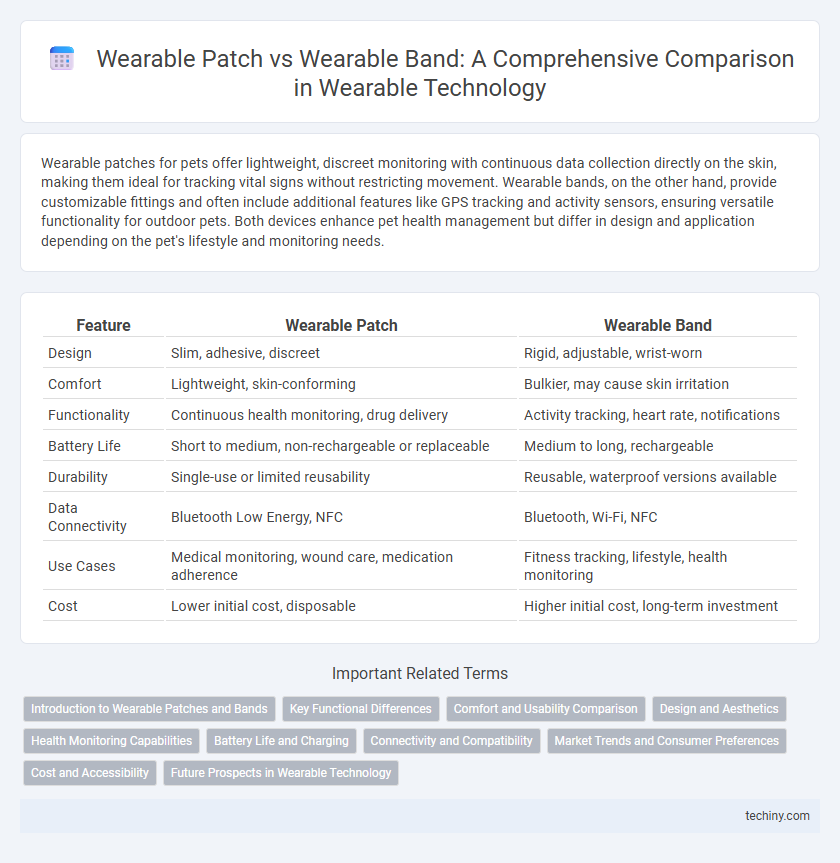Wearable patches for pets offer lightweight, discreet monitoring with continuous data collection directly on the skin, making them ideal for tracking vital signs without restricting movement. Wearable bands, on the other hand, provide customizable fittings and often include additional features like GPS tracking and activity sensors, ensuring versatile functionality for outdoor pets. Both devices enhance pet health management but differ in design and application depending on the pet's lifestyle and monitoring needs.
Table of Comparison
| Feature | Wearable Patch | Wearable Band |
|---|---|---|
| Design | Slim, adhesive, discreet | Rigid, adjustable, wrist-worn |
| Comfort | Lightweight, skin-conforming | Bulkier, may cause skin irritation |
| Functionality | Continuous health monitoring, drug delivery | Activity tracking, heart rate, notifications |
| Battery Life | Short to medium, non-rechargeable or replaceable | Medium to long, rechargeable |
| Durability | Single-use or limited reusability | Reusable, waterproof versions available |
| Data Connectivity | Bluetooth Low Energy, NFC | Bluetooth, Wi-Fi, NFC |
| Use Cases | Medical monitoring, wound care, medication adherence | Fitness tracking, lifestyle, health monitoring |
| Cost | Lower initial cost, disposable | Higher initial cost, long-term investment |
Introduction to Wearable Patches and Bands
Wearable patches are thin, flexible sensors applied directly to the skin, offering continuous health monitoring through biometric data collection such as heart rate, hydration, and glucose levels. Wearable bands, typically worn on the wrist, provide convenience and multifunctional capabilities, including activity tracking, notifications, and sleep analysis. Both devices utilize advanced materials and wireless connectivity to enhance personalized health and fitness management.
Key Functional Differences
Wearable patches provide continuous, non-invasive monitoring by adhering directly to the skin, enabling real-time biometric data collection such as glucose levels or hydration status. In contrast, wearable bands primarily offer activity tracking, heart rate monitoring, and fitness-related metrics through sensors embedded in wristbands or straps. The patch's adhesive design supports extended wear and localized sensing, while bands emphasize convenience, adjustability, and multifunctional features like notifications and GPS integration.
Comfort and Usability Comparison
Wearable patches offer superior comfort by adhering directly to the skin, minimizing bulk and allowing for discreet, all-day wear without restriction. In contrast, wearable bands can feel cumbersome during extended use and may cause skin irritation due to constant friction and sweat accumulation. Usability improves in patches with hands-free operation and minimal adjustment, while bands typically require periodic tightening and repositioning to maintain accurate sensor contact.
Design and Aesthetics
Wearable patches offer a discreet, lightweight design that seamlessly adheres to the skin, providing minimal visual impact and enhanced comfort for continuous monitoring. Wearable bands, often crafted from silicone or fabric, emphasize durability and adjustable sizing, allowing for customizable fit and a more prominent style statement. Both designs prioritize user experience, but patches excel in invisible integration while bands balance aesthetics with ruggedness.
Health Monitoring Capabilities
Wearable patches offer continuous, non-invasive health monitoring by adhering directly to the skin, enabling real-time tracking of vital signs such as heart rate, hydration levels, and glucose concentrations. In contrast, wearable bands primarily track fitness metrics like steps, calories burned, and sleep quality but may lack the precision and medical-grade sensors found in patches. The integration of advanced biosensors in wearable patches allows for more comprehensive health monitoring, making them ideal for chronic disease management and critical health diagnostics.
Battery Life and Charging
Wearable patches typically feature flexible, low-power electronics that enable longer battery life, often lasting several days without recharge due to their energy-efficient design. Wearable bands, while offering more robust functionality and larger batteries, usually require daily or every few days charging because of higher power consumption from sensors and displays. Advances in wireless charging and battery optimization continue to extend usage times for both wearable patches and bands, improving user convenience and device reliability.
Connectivity and Compatibility
Wearable patches offer seamless skin adhesion and superior sensor integration, often featuring Bluetooth Low Energy (BLE) connectivity for real-time health monitoring, while wearable bands prioritize versatility with multi-device compatibility across iOS and Android platforms. Patches typically support direct data transmission to dedicated medical apps, providing enhanced accuracy for clinical assessments, whereas bands enable broader ecosystem integration, including fitness trackers and smart home devices. Both devices emphasize low-latency communication, but patches excel in specialized healthcare interoperability, contrasting with bands' expansive compatibility in consumer technology.
Market Trends and Consumer Preferences
Wearable patches are gaining market traction due to their discreet design and continuous health monitoring capabilities, appealing to consumers seeking minimalistic and non-intrusive devices. In contrast, wearable bands continue to dominate due to their multifunctionality, including fitness tracking, notifications, and customization options, attracting a broader user base. Market trends indicate a growing preference for hybrid devices that combine the patch's accuracy with the band's versatility, driven by advancements in sensor technology and user demand for comprehensive health data.
Cost and Accessibility
Wearable patches generally offer a lower cost and greater accessibility compared to wearable bands due to their simpler design and materials, making them ideal for large-scale health monitoring. These patches are often disposable and easier to produce, reducing overall expenses for consumers and healthcare providers. In contrast, wearable bands tend to be more expensive because of advanced features, reusable materials, and longer lifespan, which can limit accessibility for some users.
Future Prospects in Wearable Technology
Wearable patches offer advanced biometrics monitoring with continuous, non-invasive data collection that enhances personalized healthcare and chronic disease management. Wearable bands provide versatile, multi-sensor platforms with extended battery life, supporting fitness tracking, health insights, and integration with smart ecosystems. Future prospects in wearable technology leverage AI-driven data analytics and improved material science to deliver seamless, real-time health monitoring and proactive wellness interventions.
Wearable Patch vs Wearable Band Infographic

 techiny.com
techiny.com